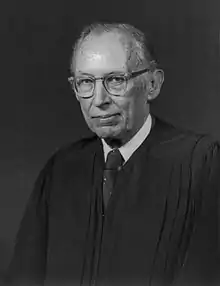Caban v. Mohammed
Caban v. Mohammed, 441 U.S. 380 (1979), was a United States Supreme Court family law case which argued that a New York law, which allowed unwed mothers, but not unwed fathers, a veto over the adoption of that couple's children, was discriminatory.[1][2]
| Caban v. Mohammed | |
|---|---|
 | |
| Argued November 6, 1978 Decided April 24, 1979 | |
| Full case name | Abdiel Caban, Appellant, v. Kazim Mohammed and Maria Mohammed. |
| Docket no. | 77-6431 |
| Citations | 441 U.S. 380 (more) 99 S. Ct. 1760; 60 L. Ed. 2d 297; 1979 U.S. LEXIS 92 |
| Case history | |
| Prior | Matter of David A.C., 56 A.D.2d 627, 391 N.Y.S.2d 846 (App. Div. 2d Dept. 1977); appeal dismissed, 43 N.Y.2d 708, 401 N.Y.S.2d 208, 372 N.E.2d 42 (1977); probable jurisdiction noted, 436 U.S. 903 (1978). |
| Holding | |
| The sex-based distinction in New York's Domestic Relations Law between unmarried mothers and unmarried fathers violates the Equal Protection Clause of the Fourteenth Amendment because it bears no substantial relation to any important state interest. | |
| Court membership | |
| |
| Case opinions | |
| Majority | Powell, joined by Brennan, White, Marshall, Blackmun |
| Dissent | Stewart |
| Dissent | Stevens, joined by Burger, Rehnquist |
| Laws applied | |
| Equal Protection Clause | |
Background
At the time of this case, § 111 of New York's Domestic Relations Law required any adoption of a child to be limited by the consent of either married parent of a child, but only the mother in the case that the parents had never married. The law, in part, read:
consent to adoption shall be required as follows: . . . (b) Of the parents or surviving parent, whether adult or infant, of a child born in wedlock; [and] (c) Of the mother, whether adult or infant, of a child born out of wedlock. . . .[1][3]
Abdiel Caban and his partner Maria Gonazles lived together for five years, during which time they had a son, and later, a daughter.[4][5] After separating in 1973, Maria later married to Kazim Mohammed. Two years later, Kazim filed to legally adopt the children. Caban had also married to his new wife Nina, they also filed for adoption, but due to § 111, that attempt was blocked, and the Mohammed's request was granted. Caban appealed unsuccessfully to the New York Supreme Court, Appellate Division and then the New York Court of Appeals, after which he appealed to the United States Supreme Court, arguing violations of both equal protection and due process.[2][6][7]
New York argued for the law's distinction, expressing the concern that allowing an unwed father to veto his child's adoption might have the effect of discouraging adoption, which wouldn't be in the best interests of the children.[8]
Opinion of the Court

The Court split 5-4, with Justice Lewis F. Powell, Jr. writing the majority opinion. That opinion found that § 111 of New York's Domestic Relations Law unconstitutionally discriminated on the basis of sex, conflicting with the Fourteenth Amendment's guarantee of equal protection, using an intermediate level of judicial scrutiny.[6][9] Powell's reasoning argued that Caban's formation of a "natural family", through five years of living with his partner and the children, entitled him to legal rights to those children.[10] Moreover, Powell found that treating mothers and fathers differently in § 111 did not "bear a substantial relation to the State's interest in providing adoptive homes for its illegitimate children."[1]
Powell's opinion declined to decide whether there was also a due process violation, or whether there was an additional equal protection issue in treating fathers differentially depending on whether or not they had been legally married.[1]
Stewart's dissent, on the other hand, found no violation of equal protection. Stewart believed that the process of carrying the child to term was a situational difference between mothers and fathers which, along with the state's interest in having illegitimate children adopted provided a legitimate basis for the differential treatment of unwed mothers and fathers in § 111. Similarly, Stevens' dissent found a strong interest in promoting adoption and that maternity created a significant difference in physical and psychological parenting between biological mothers and fathers.[11][12]
Subsequent developments
As a result of the ruling, Caban regained the visitation rights he had enjoyed before the original decision granting adoption to Kazim Mohammed.[8]
References
- Caban v. Mohammed, 441 U.S. 380 (1979).
- Hartman, Gary R.; Mersky, Roy M.; Tate, Cindy L. (2009-01-01). Landmark Supreme Court Cases: The Most Influential Decisions of the Supreme Court of the United States. Infobase Publishing. pp. 45–. ISBN 9781438110363. Retrieved 29 December 2012.
- (State), New York; McKinney, William Mark (2010). McKinney's Consolidated Laws of New York Annotated. West Publishing Company. p. 85. Retrieved 30 December 2012.
- Mann, Jim (May 16, 1979). "Unwed dads get aid from high court". Anchorage Daily News. Retrieved 30 December 2012.
- Young, Rowland L. (June 1979). "Supreme Court Report". ABA Journal. American Bar Association. p. 954. Retrieved 30 December 2012.
- Dolgin, Janet L. (1997). Defining the Family: Law, Technology, and Reproduction in an Uneasy Age. NYU Press. pp. 105–. ISBN 9780814719176. Retrieved 30 December 2012.
- Goldstein, Leslie Friedman (1988). Constitutional Rights Women: Cases in Law & Social Change. Univ of Wisconsin Press. pp. 208–. ISBN 9780299112448. Retrieved 30 December 2012.
- Greenhouse, Linda (April 25, 1979). "Adoption Law Rejected by High Court" (PDF). The New York Times. Retrieved 30 December 2012.
- Lindgren, J. Ralph; Taub, Nadine; Wolfson, Beth Anne; Carla M. Palumbo (2010-01-01). The Law of Sex Discrimination. Cengage Learning. pp. 291–. ISBN 9780495793229. Retrieved 29 December 2012.
- Dolgin, p. 106
- Hartman, p. 46
- Dolgin, p. 107
External links
- Text of Caban v. Mohammed, 441 U.S. 380 (1979) is available from: CourtListener Findlaw Google Scholar Justia Library of Congress Oyez (oral argument audio)
